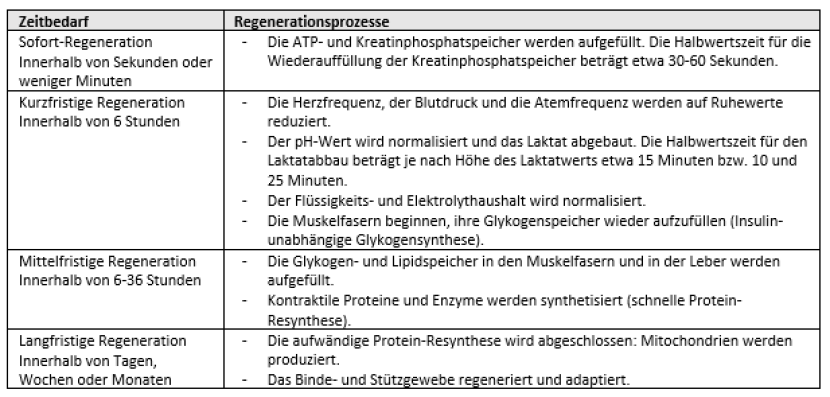Conclusion / Regeneration
Cool-down
Many athletes skip the cool-down after training. Even in sports lessons, the final part, the cool-down, is often far too short or omitted altogether. If at all, the final part usually consists of 2-3 stretching exercises that are performed carelessly. However, stretching only has a limited connection with the cool-down, but can be carried out after running out. Most athletes/trainers do not realise that a carefully performed cool-down can significantly reduce recovery time and thus achieve better training results.
Cooling down means reducing the intensity of the exercise at the end of the training session. The recommended heart rate is approximately 60% of the maximum HR (approx. 100-120 beats per minute). The duration depends on the duration and intensity, although 5 minutes is normally sufficient. More time should be invested after strenuous training with many anaerobic phases. However, more than ten minutes is not advisable, as the glycogen stores continue to be depleted during the run-out. Running out slowly (or coasting, swimming out) after a workout lowers the heart rate evenly. This improves the blood supply to the muscles that were previously under a lot of strain, rather than just keeping the legs elevated. At the same time, this active recovery helps to break down the metabolic product lactate (lactic acid that collects in the muscle during hard exertion) more quickly. In addition to the increased blood flow to the muscles, the accelerated removal of metabolic products and relaxation of the muscles, the cool-down slowly lowers the body temperature. Furthermore, muscles shortened by training are restored to their original length and the blood flow is re-regulated by redistributing the blood away from the muscles and towards the other organs. The cool-down thus gives the body time to adjust to the change from high exertion to rest and avoids an abrupt end. The cool-down also gives the psyche time to adjust. A training session or competition is therefore not only processed physically by running out, but also to a large and important extent psychologically. This has the advantage that the resentment over a match situation or the stress level is not carried over into the rest of the day, home or even into the night's sleep.
In addition to running out, stretching is also an issue at the end of a sports session. If the muscles are put under a lot of strain during sport, they can quickly harden, which triggers the athlete's need to stretch the muscles afterwards. However, this does not always lead to the desired result, as stretching is an often-discussed and complex topic. However, those who follow the principle of dynamic stretching before exercise and static stretching after exercise are doing the essentials right. However, stretching exercises are not the right thing to do after every sports session. The areas of application are pre-stretching as part of the warm-up, post-stretching as a cool-down or stretching as a separate training session. The stretching programme should always be based on the previous exercise. Prolonged static stretching after intensive exercise is not advisable, as the primary aim of the cool-down should be to reduce the metabolic product lactate as quickly as possible. However, static stretching can reduce the blood flow to the muscle and even extend the recovery time. Active running without a stretching programme is much more effective in this case. Extensive stretching may also not be advisable during intensive strength training. However, post-exercise stretching can be beneficial with less strenuous exercise.
Regeneration and adaptation processes
Each subsystem of the body adapts and recovers at different speeds. This is an important principle that must be taken into account when planning training. Because passive structures in particular are slow to adapt and recover, there is a high risk of injury or chronic disability if new training stimuli are introduced too early.

If the balance between exertion and recovery is disturbed, there is a drop in performance. In the short term, this is known as overreaching, and if the effect lasts longer, it is referred to as overtraining syndrome. Overreaching requires a recovery period of two weeks and manifests itself in fatigue, listlessness, sour muscles, depressive mood, etc. Overtraining syndrome, on the other hand, is a pathological symptom complex. It is a systematic exhaustion and can be compared to burn-out. Treatment involves medical intervention and abstaining from exercise for six to eight weeks.
During the recovery phase, the body adapts to the increased demands placed on it by the training stimulus. When planning training, regeneration should be planned in exactly the same way as the training sessions. Only through good regeneration is it possible to maintain or even increase performance. The body regenerates by itself, but regeneration can be optimised and accelerated by subsequent measures, whereby a distinction can be made between active and passive regeneration.
Immediately after sport
Drink: Fluids lost through sweat need to be replenished. Sugary drinks can also be used to replenish carbohydrate stores at the same time.
Running out (coasting, swimming out): Reduce lactate, wind down (also mentally)
Showering: Removes sweat, salt and really kicks off the recovery phase.
After the shower
Drinking: Continue to drink fluids.
Eat: Carbohydrates, proteins and other nutrients are needed to replenish stores, repair damage to structures or build new structures (e.g. muscles). This should be done within 40-60 minutes after exercise.
Avoid alcohol and nicotine and use psychoregulatory measures (yoga, tai chi) for active recovery and relaxation.
Get enough sleep at night.
The next day
Balanced diet and light physical activity to stimulate circulation, which also improves regeneration.
Relax, loosen up, stretch, massage, steam bath or sauna.